
LOS ANGELES, CALIFORNIA – AUGUST 2008: Brett Cookingham and Matt Pavolaitis, founders, owners, and operators of 251 Music, are remarkably busy. In only a few short years, they have placed over 3,000 pieces of original, high-quality music, of every conceivable genre, on network television. On one day, they may be writing and recording a country tune and the next a blazing loud rock anthem, with some folk or jazz in the evening to break things up! They wear the many hats of producer, recording engineer, composer, musician, mix engineer, and mastering engineer – often simultaneously. Ardently opposed to using pre-recorded loops or samples, Cookingham and Pavolaitis record everything themselves in their well-appointed live room/control room/mastering suite. They recently received a significant leg up in that process with a pair of “relentlessly truthful” ATC SCM50ASL powered reference monitors.
“I guess if you’re just using loops, you could get away with some mediocre speakers, but when you’re creating your own content, it’s essential that you hear what’s happening,” explained Cookingham. “We need speakers that translate well and sound impressive across the spectrum of acoustical, orchestral, electronic, and rock styles of music. The difference between ATCs and other monitors is that the ATCs are undeniably neutral. There is no harmonic trickery to make up for deficiencies, and as a result we hear every nuance as we’re tracking or mixing.”
Their ATCs recently revealed an unpleasant surprise lurking in their otherwise pristine signal chain while recording a piece for a Lovelace Health Systems commercial. “We were recording drums,” recalled Pavolaitis. “Drums are always hard – where else but in an orchestra do you have so many instruments packed together? The ATCs let me do phase alignments clearly so everything sits well in the mix. I had been fooled for years by other speakers, but when you can actually hear what’s going on, it all makes sense.”
During playback, Pavolaitis noticed that one of the toms sounded vastly better than the other two. After a bit of experimentation, they determined that it wasn’t the mics, it wasn’t the placement, and it wasn’t anything in the mix. It was the mic pres they had used! The mic pres were supposed reissues of an historically important and proven design, but in actuality they only looked like the original and were sonically inferior to the original.
“It was a milky haze,” stated Cookingham. “The frequency response was chopped on both ends and sonically unimportant. Look’s can be deceiving. These days there is a lot of “re-issue” stuff that looks like the original. With the ATCs it is easy to examine the sound quality of these components and not be fooled by their visual appearance. If you have speakers that make everything sound good you will never know that you are capturing feeble sounds, until you hear your tracks elsewhere!”
Apart from isolating weak links, the ATCs make A/B comparisons during tracking much more effective. “There’s no question with the ATCs whether something is right or wrong,” said Pavolaitis. “That’s the battle I’m constantly fighting – is it right or not? And how do you tell? You bring in all of the elements and see how it sits. But that’s not so easy if you’re not hearing the definition between the tracks.”
“Some would say these speakers are relentless in showing you the truth,” added Cookingham. “But that’s what you have to have to get it right, reliably.”
The Lovelace mix benefited from the monitors as well. After a year with them, Pavolaitis can hear and understand things in the mix that elude most of the other engineers he speaks with. “We had four violin parts in that song, and I was able to place them not just left to right, but front to back. The violins sat about seventeen feet from the listener,” he explains, “with the drums just in front of them. Acoustic guitars went wide, with bass guitar sitting low in the middle. Even though there are only two speakers, I’m able to hear the mix in three dimensions.”
The last stage in their process is just as challenging as those that came before it. The team must prepare their song for broadcast by creating +12 and +20-wide mixes. “But how do you get this huge sound in the studio to translate to a tiny TV speaker or a home theater or a boom box or anything else?” asked Pavolaitis. “The beauty of the ATC neutrality is that if you get it sounding right on the ATCs – which is much harder than getting it to sound right on other high-end monitors – you can be assured it will sound right everywhere else. That’s critical.”
ATC’s drivers are manufactured in-house to exacting tolerances and are legendary for their many design innovations, such as the innovative SL magnet system and the company’s renowned Soft Dome mid-range driver, which achieves exceptionally broad and even dispersion to produce a flat response anywhere in the room. Situated in Aston Down in rural Gloucestershire, England, ATC was established in London in 1974 by acoustics engineer and musician, Bill Woodman.
LasVegasProAudio.com, a division of TransAudio Group, provides customers with unique equipment, useful information and long-term support.
www.lasvegasproaudio.com (702) 307-2700 www.atc.gb.net